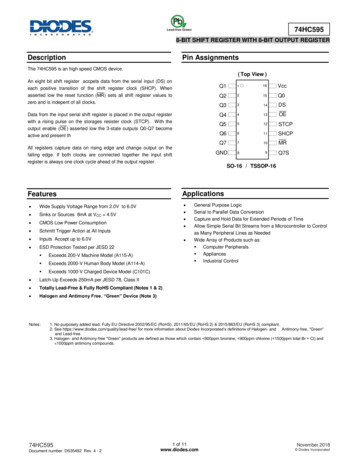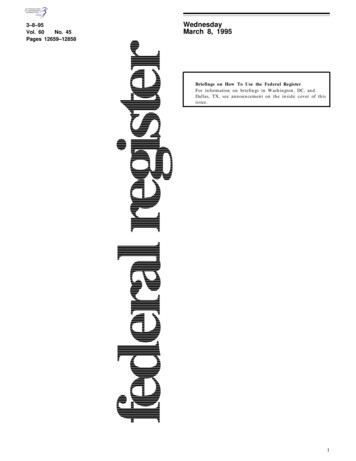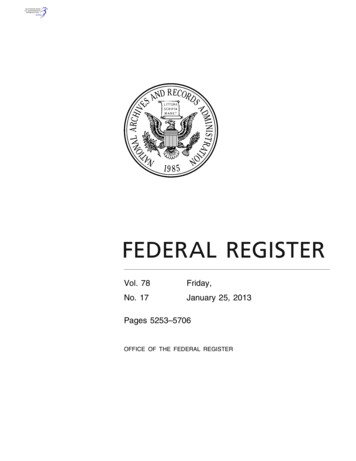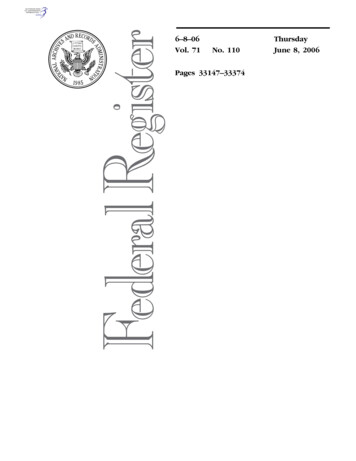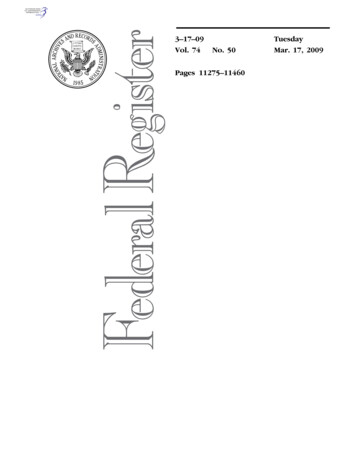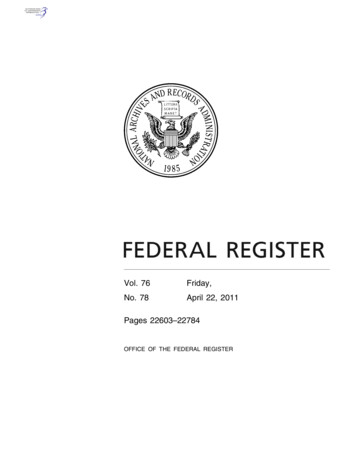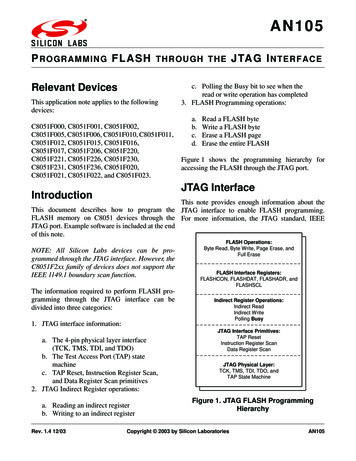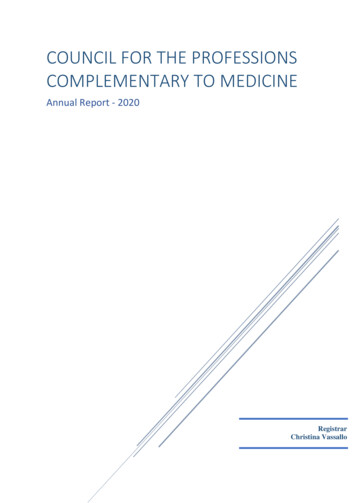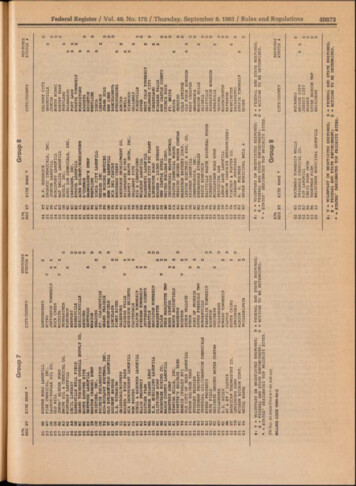
Transcription
LONDONDERRYNITROJEFFERSON TOWNSHIPROCK ILICKVILLSANDOVERKENTWOODMARIONREADINGST. CLAIRSVILLEGRAND PRAIRIESPRINGFIELDLINCKLAENPINKY RIVERGALESBURGNIAGARA FALLSMUSKEGON HEIGHTSCLOVERGALEDALTON TOWNSHIPEVESHAM TOWNSHIPJEFFERSON COUNTYSEATTLEHAMILTON TOWNSHIPMARQUETTEMILANPERE MARQUETTE TWPROSE CENTERNORTH SMITHFIELDWASHBURNHOUSTONSEVEN VALLEYSBYRONKING OF PRUSSIAUPPER FREEHOLD TWPMORGANVILLEFRANKLIN TOWNSHIPBOONTONOSSINEKEFOLLANSBEEHOWARD TOWNSHIPCLOVISSOUTH RRRRRRRRRRREEEEEEEEEEEEEEESEEEEE[FR Doc. 83-24538 Filed »-7-83; 8:45 am]BILLING CODE 6560-50-CDDDDDDDDDDDDDDDDDDRESPONSESTATUS **t V « VOLUNTARY OR NEGOTIATED RESPONSE; R - FEDERAL AND STATE RESPONSE;E - FEDERAL AND STATE ENFORCEMENT;D - ACTIONS TO BE DETERMINED. - STATES' DESIGNATED TOP PRIORITY SITES.AUBURN ROAD LANDFILLFIXE CHEMICAL, INC.LASKIN/POPLAR OIL CO.OLD MILLJOHNS' SLUDGE PONDSWOPE OIL 6 CHEMICAL CO.WINTHROP LANDFILLCECIL LINDSEYZANESVILLE WELL FIELD(BAND TRAVERSE OVERALL SUPPLY CO.SOUTH ANDOVER SITEKENTWOOD LANDFILLMARION (BRAGG) DUMPPRISTINE, INC.BUCKEYE RECLAMATIONBIO-ECOLOGY SYSTEMS, INC.OLD'SPRINGFIELD LANDFILLSOLVENT SAVERSO.S. TITANIUMGALESBURG/KOPPERSHOOKER - HYDE PARKSCA INDEPENDENT LANDFILLMGM BRAKESDUELL A GARDNER LANDFILLELLIS PROPERTYDI8TLER FARMHARBOR ISLAND LEADE.H. SCHILLING LANDFILLCLIFF/DON DUMP HOMESTAKE MINING CO.MASON COUNTY LANDFILLCEMETERY DUMPSTAMINA MILLS, INC.PINETTE'S SALVAGE YARDHARRIS (FARLEY ST)OLD CITY OF YORK LANDFILLBYRON SALVAGE YARDSTANLEY KESSLERFRIEDMAN PROPERTYIMPERIAL OIL/CHAMPION CHEMICALSMYERS PROPERTYPEPE FIELDOSSINEKE GROUND WATER CONTAMFOLLANSBEEU.S. AVIEXAT & SF / CLOVISAMERICAN THERMOSTAT CO.LEWISBURG DUMPMCGRAW EDISON CORP.METAL BANKS01 NH03 WV05 OH05 OH07 KS02 NJ01 ME06 AR05 OH05 MI05 MN05 MI05 ZM05 OB05 OH06 TX01 VT02 HY03 VA05 IL02 NY05 MI09 CA05 MI02 NJ04 KY10 WA05 OH05 MI06 NM05 MI05 MI01 RI01 ME06 TX03 PA05 IL03 PA02 NJ02 NJ02 NJ02 NJ05 MI03 WV05 MI06 NM02 NY04 TN05 MI03 PAG ro u p 7SITE NAME *EPAREG NJGroup 8B.F. GOODRICHORGANIC CHEMICALS, INC.JUNCOS LANDFILLMUNISPORT LANDFILLM&T DELISA LANDFILLGOULD, INC.AUTO ION CHEMICALS, INC.CAROLAWN, INC.SPARTA LANDFILLACME SOLVENT/MORRISTOWNO'CONNORRASMUSSEN'S DUMPWESTLINEIONIA CITY LANDFILLWEDZEB INC X MIRING DEVICESNEW LYME LANDFILLRCA DEL CARIBEBRODHEAD CREEKANDERSON DEVELOPMENT CO.SHIAWASSEE RIVERHARVEY A KNOTT DRUM, INC.GALLAWAY PITSBIG D CAMPGROUNDWILDCAT LANDFILLBLOSENSKI LANDFILLDELAWARE CITY PVC PLANTLIMESTONE ROADHOOKER - 102ND STREETNEW CASTLE STEELUNITED NUCLEAR CORP.INDUSTRIAL WASTE CONTROLCELTOR CHEMICAL WORKSPERDIDO (BOUND WATER CONTAMMARATHON BATTERY CORP.LEHIGH ELECTRIC A ENG. CO.SKINNER LANDFILLCHEMTRONICS, INC.SHENANDOAH STABLESBAYOU BONFOUCASALTVILLE WASTE DISPOSAL PONDSKIMBERTONMIDDLETOWN ROAD DUMPPESTICIDE LABLEMON LANE LANDFILLARRCOM (DREXLER ENTERPRISES)FISCHER A PORTER CO.JIBBOOM JUNKYARDA. 0. POLYMERDOVER MUNICIPAL WELL .4SITE NAME *CALVERT CITYGRANDVILLEJUNCOSNORTH MIAMIASBURY PARKPORTLANDKALAMAZOOFORT LAWNSPARTA NONJUANA DIAZNEW AWAYKINGSVILLEDOVERWEST CALN TOWNSHIPDELAWARE CITYCUMBERLANDNIAGARA FALLSNEW CASTLE COUNTYCHURCH ROCKFT. SMITHHOOPAPERDIDOCOLD SPRINGSOLD FORGE BOROUGHWEST CHESTERSWANNANOAMOSCOW MILLSSLIDELLSALTVILLEKIMBERTON RSACRAMENTOSPARTA JTXNJPAPAILGroup 9ROCKAWAY TOWNSHIP WELLSTRIANGLE CHEMICAL CO.PJP LANDFILLCRAIG FARM DRUMVOORTMAN FARMBELVIDERE MUNICIPAL LANDFILLSITE NAME *ROCKAWAYBRIDGE CITYJERSEY CITYPARKERUPPER SAUCON TWPBELVIDERECITY/COUNTYREDDDDDRESPONSESTATUS #li V » VOLUNTARY OR NEGOTIATED RESPONSE; R » FEDERAL AND STATE RESPONSE;B - FEDERAL AND STATE ENFORCEMENT;D - ACTIONS TO BE DETERMINED.* - STATES' DESIGNATED TOP PRIORITY SITES.020602030305EPAREG STDDDDDDDDDDDDDDDDDDD0DD0DDDDRESPONSESTATUS #* V « VOLUNTARY OR NEGOTIATED RESPONSE; R - FEDERAL AND STATE RESPONSE;E » FEDERAL AND STATE ENFORCEMENT;D * ACTIONS TO BE DETERMINED.STATES' DESIGNATED TOP PRIORITY 090202EPAREG STFederal Register / Voi. 48, No. 175 / Thursday, September 8,1983 / Rules and Regulations40673
Federal Register / Vol. 48, No. 175 / Thursday, September 8,1983 / Proposed Rules40 6 74E N V IR O N M E N T A L P R O T E C T IO NAGENCY4 0 C F R P a rt 300[S W E R -F R L 2421-2]A m e n d m e n t t o N a tio n a l O il a n dH a z a r d o u s S u b s ta n c e s C o n t in g e n c yP la n ; N a tio n a l P rio ritie s L is tAGENCY:Environmental ProtectionAgency.a c t io n:Proposed rule.S u m m a r y : The Environmental ProtectionAgency (“EPA” ) is proposing the firstupdate to the National Priorities List(“NPL” ) which is promulgated today asAppendix B of the National Oil andHazardous Substances ContingencyPlan (“NCP” ), pursuant to section 105 ofthe Comprehensive EnvironmentalResponse, Compensation, and LiabilityAct of 1980 (“CERCLA") and ExecutiveOrder 12316. CERCLA requires that theNPL be revised at least annually, andtoday’s notice proposes the first suchrevision.d a t e s : Comments may be submitted onor before November 7,1983.a d d r e s s e s : Comments may be mailedto Russell H. Wyer, Director, HazardousSite Control Division, Office ofEmergency and Remedial Response(WH-548E), Environmental ProtectionAgency, 401 M Street, S.W .,Washington, D.C. 20460. The publicdocket for the update to the NCP willcontain Hazard Ranking System scoresheets for all sites on the proposedupdate, as well as a “DocumentationRecord” for each site describing theinformation used to compute the scores.The main docket is located in Room S 325 of Waterside Mall, 401 M Street,S.W ., Washington, D.C., and is availablefor viewing from 9.00 a.m. to p.m.,Monday through Friday, excludingholidays. Requests for copies of thesedocuments should be directed to EPAHeadquarters, although the samedocuments will be available for viewingin the EPA Regional Offices. In addition,the background data relied upon by theAgency in calculating or evaluating HRSscores are retained in the RegionalOffices. Any such data in EPA files maybe obtained upon request. An informalwritten request, rather than a formalrequest under the Freedom ofInformation Act, should be the ordinaryprocedure for requesting these datasources. Addresses for the RegionalOffice dockets are:Jenifer Arns, Region I, U.S. EPA Library,John F. Kennedy Federal Bldg.,Boston, M A 02203, 617/223-5791Audrey Thomas, Region II, U.S. EPALibrary, 10th Floor, New York, NY10278, 212/264-2881Diane McCreary, Region III, U.S. EPALibrary, Curtis Building, 6th & WalnutStreets, Philadelphia, PA 19106, 215/597-0580Carolyn Mitchell, Region IV, U.S. EPALibrary, 345 Courtland Street NE., 404/257-4216Lou Tilly, Region V, U.S. EPA Library,230 South Dearborn Street, Chicago, IL60604, 512/353-2022Nita House, Region VI, U .S. EPALibrary, First International Building,1201 Elm Street, Dallas, TX 75270,214/767-7341Connier McKenzie, Region VII, U .S. EPALibrary, Kansas City, M O 64106, 816/374—3497Delores Eddy, Region VIH, U.S. EPALibrary 1860 Lincoln Street, Denver,C O 80295, 303/837-2560Jean Circiello, Region IX, U.S. EPALibrary, 215 Fremont Street SanFrancisco, C A 94105,415/974-8076Julie Sears, Region X, U.S. EPA Library,1200 6th Avenue, Seattle, W A 98101,206/442-1289.FOR FURTHER INFO R M ATIO N C O N T A C T :C. Scott Parrish, Hazardous Site ControlDivision, Office of Emergency andRemedial Response (WH-548E),Environmental Protection Agency, 401 MStreet, S.W ., Washington, D.C. 20460,Phone (800) 424-9346 (or 382-3000 in theWashington, D.C., metropolitan area).SUPPLEM ENTAR Y INFOR M ATION:Table of ContentsI. NPL Update Process and ScheduleII. Contents of the Proposed UpdateIII. Additional Criteria for ListingIV. Regulatory Impact AnalysisV. Regulatory Flexibility Act AnalysisI. NPL Update Process and SchedulePursuant to the ComprehensiveEnvironmental Response,Compensation, and Liability Act of 1980(CERCLA), 42 U.S.C. §§ 9601-9657, EPAis required to establish, as part of theNational Contingency Plan (NCP) forresponding to releases of hazardoussubstances, a National Priorities List(NPL) of sites of such releases. The NPLserves as guidance to EPA in settingpriorities among sites for furtherinvestigation and possible responseactions. After proposing over 400 sitesfor inclusion on the NPL on December30,1982 (47 FR 58476), EPA hasestablished a final NPL, which is beingpublished in today’s Federal Registerimmediately preceding this updateproposal. The preamble to that final listexplains in more detail the purpose ofthe NPL, the criteria used to develop thelist, and how it will be administered andrevised. The purpose of this notice is topropose the addition of 133 new sites tothe NPLCERCLA requires that the NPL berevised at least once per year, andtoday's notice proposes the first suchrevision. EPA believes, however, that itmay be desirable to update the list on amore frequent basis. Thus, the Agencymay revise the NPL more often than isspecified in CERCLA. For each revision,EPA will inform the States of the closingdates for submission of candidate sitesto EPA. In addition to these periodicupdates, EPA believes it may.bedesirable in rare instances to proposeseparately the addition of individualsites on the NPL as the Agency did inthe case of the Times Beach, Missouri,site.As with the establishment of theinitial NPL, States have the primaryresponsibility for selecting and scoringsites that are condidates for inclusion onthe NPL using the Hazard RankingSystem (HRS) and submitting thecandidates to the EPA Regional Offices.The regional Offices then conduct aquality control review of the States’candidate sites. After conducting thisreview, the EPA Regional Offices submitcondidate sites to EPA Headquarters.The Regions may include candidatesites in addition to those submitted byStates. In reviewing these submissions,EPA Headquarters conducts furtherquality assurance audits to ensureaccuracy and consistency among thevarious EPA and State officesparticipating in the scoring,EPA anticipates that each updatepublication will list sites in threecategories: the “Current List;” “ProposedAdditions;” and “Proposed Deletions”.Sites on the “Current List” are thosewhich have previously been proposedfor listing, either in the initial NPLprocess or in any subsequent updateproposal, and for which final scoreshave been established based on publiccomment and further investigation byEPA. In today’s proposal, the “CurrentList” consists of the final NPL publishedimmediately preceding this proposedupdate notice. A s explained more fullyin the preamble to the final NPLpublished today, once a site appears onthe final “Current List,” EPA does notexpect to recalculate its HRS score.Although EPA does not plan to consideradditional information on such sites forpurposes of rescroing, the Agencyalways welcomes information on a sitethat may be useful in determining moreprecisely the nature of the release andwhat response actions may beappropriate.
Federal Register / Vol. 48, No. 175 / Thursday, September 8, 1983 / Proposed Rules“Proposed Additions” consist of sitesnot currently on the NPL that theAgency is proposing to add to the NPL.The “Proposed Additions” for thisupdate are those contained in the listimmediately following this preamblediscussion. The Agency is requestingpublic comment on whether it isappropriate to add these sites to thefinal NPL, and may recalculate sitescores based on comments receivedduring the comment period.“Proposed Deletions” will consist ofsites on the current NPL that EPAproposes to delete because listing of thesite no longer is appropriate. EPA is nottoday proposing to delete any sites fromthe N PL The Agency will considerdeleting sites on a case by case basis,according to internal EPA guidancecurrently being developed. Deletionsmay be based on such circumstances asthe fact that the site has been cleanedup by EPA or the responsible party, or adetermination that no fund-financedcleanup is appropriate. EPA does notanticipate, however, that deletions willbe based on recalculations of a site’sHRS score. The criteria for deletionunder consideration by EPA arediscussed more fully in the preamble tothe final NPLIL Contents of the Proposed UpdateEach entry on the final NPL as well asproposed additions and deletions,contains the name of the facility, theState and city or county in which it islocated, and the corresponding EPARegion. Each site EPA is proposing toadd is placed by score in a groupcorresponding to the groups of 50 sitespresented on the final N PL Thus, thesites in group 1 of the proposed updatehave scores that fall within the range ofscores covered by the first 50 sites onthe final NPL. Each entry on theproposed update, as well as those on thefinal NPL, is accompanied by one ormore notations on the status of responseand enforcement activities at the site atthe time the list was prepared orupdated. These status categories aredescribed briefly below.Voluntary or Negotiated Response(V). Sites are included in this category ifprivate parties are taking responseactions pursuant to a consent order oragreement to which EPA is a party.Voluntary or negotiated cleanup mayinclude actions taken pursuant toagreements reached after enforcementaction had commenced. This category ofresponse may include remedialinvestigations, feasibility studies, andother preliminary work, as well asactual cleanup.Even though response actions qualifyfor notation in this category only ifsanctioned by a formal agreement thisis not intended to preclude responsibleparties from taking voluntary responseactions outside of such an agreement.However, in order for the site to bedeleted, or to be noted in the Voluntaryor Negotiated Response category, EPAmust still sanction the complete cleanup.If the remedial action is not fullyimplemented or is not consistent withthe NCP, the responsible party may besubfect to an enforcement action.Therefore, most responsible parties mayfind it in their best interest to negotiatea consent agreement.Federal and State Response (R). TheFederal and State Response categoryincludes sites at which EPA or Stateagencies have commenced or completedremoval or remedial actions underCERCLA, including remedialinvestigations and feasibility studies(see NCP section 300.68(f)(i)). Forpurposes of this categorization, EPAconsiders the response action to havebegun when LPA has obligated funds.For some of the sites in this category,remedial investigations and feasibilitystudies may be followed by EPAenforcement actions, at which time thesite status will change to "Federal orState Enforcement.”Federal or State Enforcement (E). Thiscategory includes sites where the UnitedStates or the State has filed a civilcomplaint or issued an administrativeorder. It also includes sites at which aFederal or State court has mandatedsome form of no-consensual responseaction following a judicial proceeding. Itmay not, however, include all sites atwhich preliminary enforcementactivities are underway. A number ofsites that EPA is proposing to add to theNPL are the subject of enforcementinvestigation or have been formallyreferred to the Department of Justice forenforcement action. EPA’s policy is notto release information concerning apossible enforcement action until alawsuit has been filed. Accordingly,these sites have not been included in theenforcement category.Actions to be Determined (D). Thiscategory includes all sites not listed inany other category. A wide range ofactivities may be in progress for sites inthis category. The Agency may beconsidering a response action, or maybe conducting an enforcementinvestigation. EPA may have referred acase involving a site to the Departmentof Justice, but no lawsuit has yet beenfiled. Investigations may be underwayor needed to determine the source of arelease in areas adjacent to or near aFederal facility. Responsible partiesmay be undertaking cleanup operationsthat are unknown to the Federal or State40675government, or corrective action maynot be occurring yet.EPA requests public comment on eachof the sites it is proposing to add to theN PL and will accept such comments for60 days following the date of this notice.A “Documentation Record” and HRSscoring sheets for all proposed sites areavailable for inspection and copying inthe NPL docket located in Washington,D .C. These documents are also availablein the EPA Regional Offices, as arebackground data referred to in theDocumentation Records and relied onfor scoring. In some instances, whereStates calculated site scores and EPAreview and quality control checking didnot require direct inspection ofbackground data, these data may beavailable only from the State thatconducted the original scoring. Afterconsidering the relevant commentsreceived during the comment period anddetermining the final score for eachproposed site, the Agency will add tothe current NPL at the time of the nextupdate all sites that meet EPA’s criteriafor listing.III. Additional Criteria for ListingThe preamble to the proposed NPL (47FR 58476, December 30,1982} stated thatthe more than 400 sites on the proposedlist were included based primarily ontotal scores (“migration” or “Sn,” scores)calculated according to the HRS. For theproposed NPL, all sites (with theexception of some sites designated byStates as “top priority” sites} scored28.50 or higher according to the HRS.EPA has found that the HRS scoringfactors provide a good estimate of therelative hazards at sites for purpose ofestablishing a list of national prioritiesfor further investigation and possibleremedial action. As explained in thepreamble to the proposed NPL (47 FR58479, December 30,1982) and thepreamble to the NCP which discussesthe HRS (47 FR 31187-88, July 18,1982),the HRS total score used for the NPL isdesigned to take into account a standardset of factors related to risks frommigration of substances through groundwater, surface water, and the air.Although the HRS also does provide anapproximation of risk from directcontact with substances and from thepossibility of fire and explosion, thesepathway scores are not considered incomputing the HRS “total score” of asite for purposes of listing. Rather,scores from the direct contact and fireand explosion pathways are used asguidance in determining the need forimmediate removal action at a site.EPA has found, however, that incertain instances EPA’s authority to
40676Federal Register / Vol. 48, No. 175 / Thursday, September 8, 1983 / Proposed Rulesconduct an immediate removal actionmay not be sufficient to addresscompletely the direct contact risks at asite, and that remedial action maytherefore be warranted. For example,where relocation of residents is theappropriate remedy, the Agency’sremoval authority extends only toevacuation of threatened residents,whereas its remedial authority mayinclude permanent relocation of thoseresidents. Although EPA can takeremoval actions, including temporaryrelocation of residents, irrespective ofwhether a site appears on the NPL, theNCP (40 CFR 300.68(a)) provides thatremedial actins may be taken only atsites on the NPL.Since the “ direct contact” scores arenot included in calculating the HRS totalscore for purposes of listing sites on theNPL, some of the sites involving directcontact to residents where remedialaction, rather than immediate removalaction, appears necessary to address theproblem completely may not receive asufficiently high HRS total score to belisted on the NPL. This situation has ledEPA to believe that in limitedcircumstances it may be appropriate toconsider other criteria than simply asufficiently high HRS total score forpurposes of listing sites on the NPL tomake them eligible for remedial action.Quail Run Mobile Manor, GraySummit, Missouri, is an example of asite that presents a significant risk to thepublic that may warrant remedialaction, although its HRS total score istoo low for the site to be included on theNPL. During the winter of 1982-1983, theEPA conducted environmental samplingat Quail Run as part of its investigationof a number of sites in the State ofMissouri that were potentiallycontaminated with dioxin. Theinvestigation of the Quail Run siterevealed widespread dioxincontamination of yards, roadsides, andgarden areas, as well as highconcentrations under the road pavementand presence in at least one residence.In the case of Quail Run, EPA believesthat a number of factors suggest that itmay be appropriate to considerincluding the site on the NPL eventhough its HRS total score is less than28.50. First, based on EPA’s sampling,the Centers for Disease Control (CDC)on May 11,1983 issued a public healthadvisory for the trailer park. Thisadvisory was based on the risk toresidents posed by direct contact withthe contaminated areas. Second theFederal Emergency ManagementAgency determined that temporaryrelocation of the residents wasnecessary to protect public health,based on the CD C avisory and itsdetermination that the possible humanexposure would continue unless theresidents left their homes. Finally, EPA’scurrent assessment is that some type ofremedial action—as opposed to animmediate removal action—may be themost health-protective and costeffective response.Therefore, EPA is proposing to addthe Quail Run site to the NPL. Includingthe Quail Run site on the NPL willpermit EPA to consider the broadestpossible range of response actions,including remedial actions, that willprotect the public health andenvironment and provide the most costeffective response.EPA recognizes, however, that thesole criterion in the NCP for listing siteson the NPL is a sufficiently high HRStotal score (or designation by a State asits top priority site). Before EPA includesthe Quail Run site on the NPL, therefore,the Agency intends to amend the NCP toauthorize consideration of limitedcriteria other than the HRS total scorefor purposes of including sites on theNPL. These alternative criteria wouldtake into account circumstances such asthose existing at the Quail Run site.In preparing a proposed amendmentto the NCP, EPA will consider theadvisability of relying in part on healthassessments or advisories such as thoseissued by the newly formed Agency forToxic Substances and Disease Registry(ATSDR) or special information from theFederal Emergency ManagementAgency. Such information could serve asthe technical basis for an EPA advisorycommittee review and subsequentadministrative decision on the relativerisk of the site. A related approach, forsituations where persons at differentlocations are affected by the risks ofdirect contact from common substances(such as dioxin), might be to group suchsites by geography or politicalsubdivision on the NPL. For example,EPA might develop some processwhereby many of the locations inMissouri involving direct contact risksfrom dioxin could be grouped into asingle listing on the NPL if a suitablehealth assessment or advisory had beenissued by an agency such as ATSDRwith respect to those locations. O fcourse, this approach could also applyto similar dioxin risksln other States orterritories.EPA anticipates, however, that anyalternative criteria it may develop willapply only to a limited number and typeof sites. With rare exception, the HRShas proven to be an effective tool forapproximating the risk posed by sites,and will remain the principal criterionfor listing. EPA invites comments on thegeneral issue of considering alternativecriteria for listing on the NPL and onapproaches such as those discussedabove, as well as on the inclusion of theQuail Run site.IV . Regulatory Impact AnalysisThe EPA has conducted a preliminaryanalysis of the economic implications oftoday’s amendment to the NCP. TheEPA belives that the direction of theeconomic effects of thia revision isgenerally similar to those effectsidentified in the regulatory impactanalysis (RIA) prepared in 1982 for therevisions to the NCP pursuant to section105 of CER CLA .1 Nevertheless, theAgency intends to go beyond this earliercharacterization of possible effects witha more extensive analysis of thecombined economic impact of thisupdate proposal and other amendmentsto the NCP that EPA may propose in thenear future. The analysis willaccompany publication of future majoramendments to the NCP. A morecomprehensive examination, togetherwith more than 2 years of experiencewith the Superfund program, will allowbetter estimates of the economic impactof this and other proposed amendments.In the meantime, the Agency belives theanticipated economic effects of adding133 sites to the NPL can becharacterized in terms of theconclusions of the earlier regulatoryimpact analysis.CostsThe costs associated with revising theNCP that were estimated in the 1982 RIAincluded costs to States of meeting costshare requirements; costs to industriesand individual firms of financingremedies at NPL sites as a result eitherof enforcement or cost recovery actionor of voluntary response; andmacroeconomic costs resulting fromeffects on industries and Stategovernments. Each of these types ofcosts is discussed below.Costs to States associated withtoday’s amendment arise from thestatutory State cost-shafe requirementof 10 percent of remedial action costs atprivately-owned sites. Using theassumptions developed in the 1982 RIA,we can assume that 90 percent of the 133sites proposed for listing in thisamendment will involve a 10 percentState cost share, and 10 percent will' TCF Incorporated, Regulatory Impact Analysis ofthe Revisions to the National Oil and HazardousSubstances Contingency Plan, February 16,1982.The analysis is available for inspection at the U.S.Environmental Protection Agency, 401 M Street, S.W., Washington, D.C. 20460.
Federal Register / Vol. 48, No. 175 / Thursday, September 8, 1983 / Proposed Rulesinvolve a 50 percent cost share atpublicly-owned sites. Estimating theaverage costs of a remedial action at 6.5 million, the cost to all States ofundertaking Federal remedial actions atall 133 sites would be 121 million.Cost to industry could result fromrequired financing of remedies at sitesoh the NPL under enforcement or costrecovery action. Firms could also beinduced to respond to sites for whichthey are responsible as a prudentbusiness action to avoid possibleenforcement actions and to preventadverse publicity if they are linked tohazardous waste sites that are nownational priority targets. Preciseestimates must await the full analysis tobe conducted; however, the range ofcosts would extend from zero (if none ofthe 133 sites is addressed) to amaximum of 865 million (if the 133 sitesare privately-owned and each remedialaction costs an average of 6.5 million).The EPA cannot identify at this timewhich firms may be threatened withspecific portions of response costs. Theact of adding a hazardous waste site tothe NPL does not itself cause firmsresponsible for that site to bear thesecosts. Instead, listing acts only as apotential trigger for subsequentenforcement, cost recovery, or voluntaryremedial efforts. Moreover, it remains atEPA’s discretion whether or not toproceed with enforcement actionsagainst firms which may be adverselyaffected by such actions.Economy-wide effects of thisamendment are aggregations of effectson firms and State and localgovernments. Although effects could befelt by some individual firms and States,the total impact of this revision onoutput, prices, and employment isexpected to be negligible at the nationallevel, as was the case in the 1982 RIA.BenefitsAssociated with'the costs aresignificant potential benefits and costoffsets. The distributional costs to firmsof financing NPL remedies havecorresponding “benefits” in that eachdollar expended for a response putssomeone to work directly or indirectly(through purchased materials).The real benefits associated withtoday’s amendment come in the form of .increased health and environmentalprotection as a result of additionalresponse actions at hazardous wastesites. In addition to the potential formore Federally-financed remedialactions, expansion of the NPL couldaccelerate privately-financed, voluntarycleanup efforts to avoid potentialadverse publicity, torts, and/orenforcement action. Listing sites asnational priority targets may also giveStates increased support for fundingresponses at particular sites.As a result of the additional NPLremedies, there will be lower humanexposure to high-risk chemicals, andhigher quality surface water, groundwater, soil, and air. The magnitude ofthese benefits is expected to besignificant, although difficult toestimate. As an example of a roughcalculation, the 1982 RIA estimated thatthe population potentially at risk fromcontamination of ground water, soil, andair would be reduced by approximately1.8 million, 600,000, and 97,000respectively, if remdial actions weretaken at 170 NPL sites. Assuming anaverage estimate per NPL site of 10,000people at risk of exposure tocontaminated ground water, responseactions at the 133 sites to be listed by40677this revision could result in a reducedrisk of exposure to ground watercontamination for up to 1.3 millionpeople.V . Regulatory Flexibility Act AnalysisAs required by the RegulatoryFlexibility Act of 1980, the Agency hasreviewed the impact of this revision tothe NCP on small entities. The EPAcertifies that the revision will not have asignificant impact on a substantialnumber of small entities.While modifications to the NPL areconsidered revisions to the NCP, theyare not typical regulation changes sincethe change does not automaticallyimpose across-the-board costs. As aconsequence, it is hard to predicteffects. The Agency does expect thatcertain industries and firms withinindustries that have caused aproportionall
il acme solvent/morristown morristown r 01 me o'connor augusta 0 05 mi rasmussen's dump brighton r 03 pa westline westline d 05 mi ionia city landfill ionia r 05 in wedzeb inc lebanon e 02 pr x miring devices juana diaz d 05 oh new lyme landfill new lyme 0 02 pr rca del caribe barcelonsta d 03 pa brodhead creek stroudsburg r 05 mi anderson .
